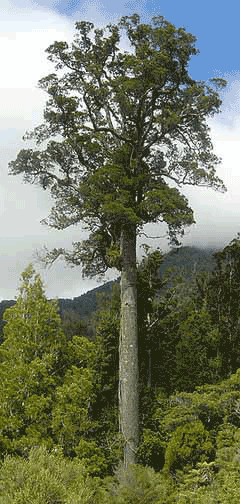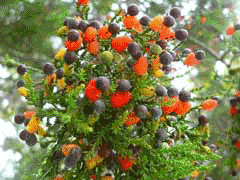 |
|
|
 |
| http://www.flickr.com/photos/sondyaustin/Dacrydium cupressinum |
Translate this page:
Summary
Physical Characteristics

 Podo is an evergreen Tree growing to 6 m (19ft 8in) at a slow rate.
Podo is an evergreen Tree growing to 6 m (19ft 8in) at a slow rate.
See above for USDA hardiness. It is hardy to UK zone 9. It is in leaf all year. The species is dioecious (individual flowers are either male or female, but only one sex is to be found on any one plant so both male and female plants must be grown if seed is required). and is pollinated by Wind. The plant is not self-fertile.
Suitable for: light (sandy), medium (loamy) and heavy (clay) soils. Suitable pH: mildly acid, neutral and basic (mildly alkaline) soils. It can grow in semi-shade (light woodland). It prefers moist soil.
UK Hardiness Map
US Hardiness Map
Synonyms
Podocarpus dacrydioides.
Plant Habitats
Edible Uses
Fruit - raw. A sweet taste[128, 153], it is palatable but with a slightly oily taste[173]. Also used as a masticatory[183] (this last report probably refers to the use of the resin). A resin is obtained from the tree[153], it is used as a chewing gum[173].
References More on Edible Uses
Medicinal Uses
Plants For A Future can not take any responsibility for any adverse effects from the use of plants. Always seek advice from a professional before using a plant medicinally.
None known
References More on Medicinal Uses
The Bookshop: Edible Plant Books
Our Latest books on Perennial Plants For Food Forests and Permaculture Gardens in paperback or digital formats.

Edible Tropical Plants
Food Forest Plants for Hotter Conditions: 250+ Plants For Tropical Food Forests & Permaculture Gardens.
More

Edible Temperate Plants
Plants for Your Food Forest: 500 Plants for Temperate Food Forests & Permaculture Gardens.
More

More Books
PFAF have eight books available in paperback and digital formats. Browse the shop for more information.
Shop Now
Other Uses
Plants are fairly amenable to trimming and could possible be grown as a hedge in mild areas of the country[200]. Wood - yellowish, easily worked. Used for general carpentry and for paper pulp[1, 46, 64, 171].
Special Uses
References More on Other Uses
Cultivation details
Requires sheltered moist woodland conditions[166]. Plants are not very frost-tolerant and are only hardy outdoors in the mildest areas of Britain[1, 81]. In their native habitat trees can reach 45 metres in height, but they are slow growing in Britain and rarely exceed 6 metres[11, 185].
References Carbon Farming Information and Carbon Sequestration Information
Temperature Converter
Type a value in the Celsius field to convert the value to Fahrenheit:
Fahrenheit:
The PFAF Bookshop
Plants For A Future have a number of books available in paperback and digital form. Book titles include Edible Plants, Edible Perennials, Edible Trees,Edible Shrubs, Woodland Gardening, and Temperate Food Forest Plants. Our new book is Food Forest Plants For Hotter Conditions (Tropical and Sub-Tropical).
Shop Now
Plant Propagation
The seed can be very slow to germinate, often taking 18 months or more. It is best sown in a cold frame as soon as it is ripe. Sow stored seed as early in the year as possible[200]. When they are large enough to handle, prick the seedlings out into individual pots and grow them on in the greenhouse for at least their first winter. Plant them out into their permanent positions in late spring or early summer, after the last expected frosts. Give them some protection from the cold for their first winter or two outdoors. Cuttings of short leading shoots, late summer in a frame[1]. Plant out in late spring after the last expected frosts. It side shoots are used as cuttings they will form prostrate plants[200].
Other Names
If available other names are mentioned here
Native Range
AUSTRALASIA: New Zealand
Weed Potential
Right plant wrong place. We are currently updating this section.
Please note that a plant may be invasive in one area but may not in your area so it's worth checking.
Conservation Status
IUCN Red List of Threatened Plants Status :

| Related Plants
|
| Latin Name | Common Name | Habit | Height | Hardiness | Growth | Soil | Shade | Moisture | Edible | Medicinal | Other |
| Dacrycarpus dacrydioides | Kahikatea | Tree | 6.0 |
8-11
| S | LMH | S | M | 2 | 0 | 3 |
| Dacrydium cupressinum | Rimu, New zealand red pine | Tree | 30.0 |
8-11
| S | LM | S | M | 2 | 0 | 3 |
| Lagarostrobus colensoi | | Tree | 0.0 |
7-10
| | LM | S | M | 0 | 0 | 2 |
| Lagarostrobus franklinii | Huon Pine | Tree | 15.0 |
7-10
| S | LM | S | M | 2 | 0 | 3 |
| Lepidothamnus intermedius | Yellow Silver Pine | Tree | 10.0 |
7-10
| S | LM | S | M | 0 | 0 | 2 |
| Microcachrys tetragona | | Shrub | 0.2 |
7-10
| S | LMH | SN | M | 2 | 0 | |
| Nageia nagi | Nagi, Nagi Podocarpus, Broadleaf Podocarpus | Tree | 25.0 |
9-11
| M | LMH | SN | M | 1 | 0 | 2 |
| Nageia wallichiana | Nageia | Tree | 20.0 |
9-12
| M | LMH | FSN | M | 0 | 2 | 4 |
| Phyllocladus alpinus | Alpine Celery Pine | Shrub | 9.0 |
7-10
| S | LMH | SN | M | 0 | 0 | 1 |
| Phyllocladus aspleniifolius | Celery Top Pine | Tree | 10.0 |
8-11
| S | LMH | SN | M | 0 | 0 | 3 |
| Phyllocladus trichomanoides | Tanekaha, Celery pine | Tree | 8.0 |
8-11
| S | LMH | SN | M | 0 | 1 | 3 |
| Podocarpium oldhamii | | Perennial | 1.2 |
-
| | LMH | N | M | 2 | 1 | 1 |
| Podocarpium podocarpum | | Perennial | 1.2 |
-
| | LMH | N | M | 1 | 0 | |
| Podocarpium podocarpum fallax | | Perennial | 1.0 |
-
| | LMH | N | M | 1 | 1 | |
| Podocarpium podocarpum japonicum | | Perennial | 1.2 |
-
| | LMH | N | M | 2 | 1 | |
| Podocarpus alpinus | Tasmanian Podocarp | Shrub | 2.0 |
6-9
| S | LMH | SN | M | 2 | 0 | 2 |
| Podocarpus elatus | Australian Plum | Tree | 30.0 |
9-11
| | LMH | SN | M | 2 | 0 | 2 |
| Podocarpus lawrencei | | Tree | 10.0 |
6-9
| | LMH | SN | M | 2 | 0 | |
| Podocarpus macrophyllus | Kusamaki, Yew plum pine, Buddhist Pine, Chinese Podocarpus, Chinese Yew Pine, Japanese Yew, Souther | Tree | 10.0 |
8-11
| S | LMH | SN | M | 2 | 1 | 3 |
| Podocarpus neriifolius | Oleander Podocarp, Brown Pine | Tree | 25.0 |
9-12
| M | LMH | SN | M | 2 | 2 | 4 |
| Podocarpus nivalis | Alpine Totara | Shrub | 3.0 |
7-11
| M | LMH | SN | M | 3 | 0 | 3 |
| Podocarpus nubigenus | Chilean Podocarp | Tree | 20.0 |
6-9
| S | LMH | SN | M | 2 | 0 | 2 |
| Podocarpus salignus | Willowleaf Podocarp | Tree | 12.0 |
7-10
| S | LMH | SN | M | 2 | 0 | 2 |
| Podocarpus totara | Totara | Tree | 30.0 |
8-11
| S | LMH | SN | M | 3 | 0 | 2 |
| Podolepis jaceoides | Copperwire Daisy | Perennial | 0.6 |
8-11
| | LM | N | M | 1 | 0 | |
| Podophyllum aurantiocaule | | Perennial | 0.3 |
6-9
| | LM | FS | M | 2 | 2 | |
| Podophyllum hexandrum | Himalayan May Apple | Perennial | 0.5 |
5-9
| | LM | FS | M | 2 | 4 | 1 |
| Podophyllum peltatum | American Mandrake, Mayapple, Ground Lemon, Mandrake, Mayapple | Perennial | 0.3 |
3-9
| M | LM | FS | M | 2 | 4 | 2 |
| Podophyllum pleianthum | | Perennial | 0.3 |
-
| | LM | FS | M | 2 | 3 | |
| Podophyllum versipelle | | Perennial | 0.3 |
-
| | LM | FS | M | 2 | 3 | |
|
|
Growth: S = slow M = medium F = fast. Soil: L = light (sandy) M = medium H = heavy (clay). pH: A = acid N = neutral B = basic (alkaline). Shade: F = full shade S = semi-shade N = no shade. Moisture: D = dry M = Moist We = wet Wa = water.
Now available:
Food Forest Plants for Mediterranean Conditions
350+ Perennial Plants For Mediterranean and Drier Food Forests and Permaculture Gardens.
[Paperback and eBook]
This is the third in Plants For A Future's series of plant guides for food forests tailored to
specific climate zones. Following volumes on temperate and tropical ecosystems, this book focuses
on species suited to Mediterranean conditions—regions with hot, dry summers and cool, wet winters,
often facing the added challenge of climate change.
Read More
Expert comment
Author
(A.Rich.)de Laub.
Botanical References
44200
Links / References
For a list of references used on this page please go here
Readers comment
| Add a comment |
|
If you have important information about this plant that may help other users please add a comment or link below. Only comments or links that are felt to be directly relevant to a plant will be included. If you think a comment/link or information contained on this page is inaccurate or misleading we would welcome your feedback at [email protected]. If you have questions about a plant please use the Forum on this website as we do not have the resources to answer questions ourselves.
* Please note: the comments by website users are not necessarily those held by PFAF and may give misleading or inaccurate information.
To leave a comment please Register or login here All comments need to be approved so will not appear immediately.
|
|